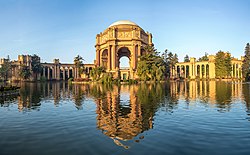Palace of Fine Arts | |
 The Palace of Fine Arts, 2020 | |
| Location | 3301 Lyon St., San Francisco, California |
|---|---|
| Coordinates | 37°48′10″N 122°26′54″W / 37.80278°N 122.44833°W |
| Area | 17 acres (6.9 ha) |
| Architect | William Gladstone Merchant; Bernard Maybeck |
| Architectural style | Beaux-Arts |
| Website | https://palaceoffinearts.com/ |
| NRHP reference No. | 04000659[1] |
| SFDL No. | 88 |
| Significant dates | |
| Added to NRHP | December 5, 2005 |
| Designated SFDL | 1977[2] |
The Palace of Fine Arts is a monumental structure located in the Marina District of San Francisco, California, originally built for the 1915 Panama–Pacific International Exposition to exhibit works of art. It was constructed from concrete and steel, and the building was claimed to be fireproof.[3] According to a metal plate at the rotunda,[4] it was rebuilt under B.F. Modglin,[5] local manager of MacDonald & Kahn, between 1964 and 1967. In the years 1973 and 1974, the columniated pylons were added.[1] It is the only structure from the exposition that survives on site.[6]
The most prominent building of the complex, a 162-foot-high (49-meter)[1] open rotunda, is enclosed by a lagoon on one side and adjoins a large, curved exhibition center on the other side, separated from the lagoon by colonnades. As of 2019, the exhibition center (one of San Francisco's largest single-story buildings) is used as a venue for events such as weddings or trade fairs.[7]
Conceived to evoke a decaying ruin of ancient Rome,[1] the Palace of Fine Arts became one of San Francisco's most recognizable landmarks.[8] Early 2009 marked the completion of a renovation of the lagoons and walkways and a seismic retrofit.
- ^ a b c d "National Register Information System – (#04000659)". National Register of Historic Places. National Park Service. March 13, 2009.
- ^ "City of San Francisco Designated Landmarks". City of San Francisco. Archived from the original on March 25, 2014. Retrieved October 21, 2012.
- ^ Circular of information: Panama-Pacific International Exposition. San Francisco: San Francisco: Department of Fine Arts. 1915. p. 5.
The Palace of Fine Arts is a fireproof building of steel and concrete construction.
- ^ "Plaque in honour of B.F.Modglin". Wiki Commons. Retrieved October 29, 2023.
- ^ "Ready for the 'biggest job in history of west (Davis–Bacon Act of 1931)" (PDF). Bureau of Reclamation. Retrieved October 29, 2023.
- ^ Cite error: The named reference
kamiyawas invoked but never defined (see the help page). - ^ "What's Happening With That Giant Building Behind the Palace of Fine Arts?". SF Weekly. January 17, 2019. Retrieved April 6, 2020.
- ^ Ting, Eric; Dowd, Katie; Amanda; Bartlett, a; SFGATE (April 4, 2020). "Bay Area coronavirus updates: SF's Palace of Fine Arts will be temporary homeless shelter". SFGate. Retrieved April 6, 2020.


